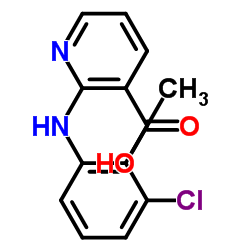clonixin

clonixin structure
|
Common Name | clonixin | ||
|---|---|---|---|---|
| CAS Number | 17737-65-4 | Molecular Weight | 262.692 | |
| Density | 1.4±0.1 g/cm3 | Boiling Point | 410.2±45.0 °C at 760 mmHg | |
| Molecular Formula | C13H11ClN2O2 | Melting Point | 242 °C | |
| MSDS | Chinese USA | Flash Point | 201.9±28.7 °C | |
| Symbol |

GHS07 |
Signal Word | Warning | |
|
Ketoprofen is more effective than diclofenac after oral surgery when used as a preemptive analgesic: a pilot study.
J. Oral Facial Pain Headache 28(2) , 153-8, (2014) To evaluate the preemptive analgesia of ketoprofen in comparison with diclofenac after mandibular third molar surgery.This study was a double-blind, randomized clinical trial. Forty patients were randomized into two treatment groups (each with 20 patients) by... |
|
|
Treatment of naturally occurring bovine respiratory disease in juvenile calves with a single administration of a florfenicol plus flunixin meglumine formulation.
Vet. Rec. 174(17) , 430, (2014) The efficacy and safety of a florfenicol plus flunixin meglumine formulation in the treatment of respiratory disease was evaluated in calves less than six weeks of age, compared with a positive control group treated with a well-established florfenicol formula... |
|
|
Plasma matrix metalloproteinase activity in horses after intravenous infusion of lipopolysaccharide and treatment with matrix metalloproteinase inhibitors.
Am. J. Vet. Res. 74(3) , 473-80, (2013) To establish an in vivo method for matrix metalloproteinase (MMP)-2 and MMP-9 induction in horses via IV administration of lipopolysaccharide (LPS) and to evaluate the ability of doxycycline, oxytetracycline, flunixin meglumine, and pentoxifylline to inhibit ... |
|
|
Comparison of the effects of IV administration of meloxicam, carprofen, and flunixin meglumine on prostaglandin E(2) concentration in aqueous humor of dogs with aqueocentesis-induced anterior uveitis.
Am. J. Vet. Res. 73(5) , 698-703, (2012) To compare the effects of meloxicam, carprofen, and flunixin meglumine administered IV on the concentration of prostaglandin E(2) (PGE(2)) in the aqueous humor of dogs with aqueocentesis-induced anterior uveitis.15 adult dogs with ophthalmically normal eyes.E... |
|
|
Phenylbutazone and flunixin meglumine used singly or in combination in experimental lameness in horses.
Equine Vet. J. Suppl. (40) , 12-7, (2011) Using an adjustable heart bar shoe model of foot pain, the objective of this study was to test the hypothesis that the combined use of phenylbutazone (PBZ) and flunixin meglumine (FM) would prove more efficacious in alleviating lameness than either drug alone... |
|
|
Anesthesia case of the month. EPAM.
J. Am. Vet. Med. Assoc. 240(1) , 40-4, (2012)
|
|
|
Stimulatory effect of PGF2α on PRL based on experimental inhibition of each hormone in mares.
Theriogenology 78(9) , 1960-8, (2012) During the luteolytic period in mares, the peak of 65% of pulses of a PGF2α metabolite (PGFM) and the peak of a pulse of PRL have been reported to occur at the same hour. It is unknown whether the synchrony reflects an effect of PGF2α on PRL or vice versa. Co... |
|
|
Validation of a rapid lateral flow test for the simultaneous determination of β-lactam drugs and flunixin in raw milk.
J. Food Prot. 75(7) , 1270-7, (2012) β-Lactam antibiotics are the most commonly used drugs on dairy farms. β-Lactam residues in milk are kept out of the human milk supply with good agricultural practices and mandatory truck screening performed by the dairy industry under Appendix N of the Pasteu... |
|
|
Ultra-performance liquid chromatography-tandem mass spectrometry determination and depletion profile of flunixin residues in tissues after single oral administration in rabbits.
J. Chromatogr. B. Analyt. Technol. Biomed. Life Sci. 934 , 8-15, (2013) An ultra-performance liquid chromatography with tandem mass spectrometric detection (UPLC-MS/MS) method was developed for the detection of flunixin residues in rabbit tissues. The samples were extracted with acidic acetonitrile, defatted with n-hexane, and th... |
|
|
Identification of the first New Zealand case of equine multinodular pulmonary fibrosis.
N. Z. Vet. J. 62(4) , 226-31, (2014) A 10-year-old polo mare presented with a history of weight loss, poor condition and inappetance.The mare was tachycardic, tachypnoeic and febrile. Harsh lung sounds were auscultated over all lung fields. The mare initially responded to treatment with antibiot... |